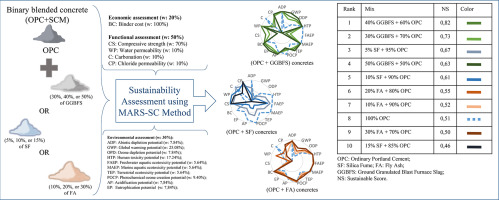Journal of Cleaner Production ( IF 11.1 ) Pub Date : 2019-02-15 , DOI: 10.1016/j.jclepro.2019.02.010 Kamel Mohamed Rahla , Ricardo Mateus , Luís Bragança

|
The process of manufacturing the Ordinary Portland Cement (OPC) is linked with potentially adverse consequences on the environment, as it consumes considerable quantities of resources and releases huge amounts of CO2 to the atmosphere. It is becoming more common to replace some proportion of OPC with by-products from other industries that once were considered as waste and sent to the landfills. Known as Supplementary Cementitious Materials (SCMs), these by-products are already being used as cement replacement materials at a growing pace in the construction sector. This results in reducing the potential environmental loads and, in some cases, improving the mechanical and durability properties of concretes. The aim of this research was to investigate the environmental, economic and functional performances of binary blended concretes containing Fly Ash (FA), Ground Granulated Blast-Furnace slag (GGBFS) and Silica Fume (SF) at different OPC substitution percentages. Using the MARS-SC method, the concretes were compared and ranked by their sustainability performances, based on a list of fifteen sustainability indicators. The results showed that concrete containing 40% of GGBFS was ranked as the most sustainable among the studied mixtures, as it presented the most suitable trade-offs to achieve the highest sustainability performance. Concrete with 15% of SF was ranked as the less sustainable, with a sustainability level lower than the conventional concrete. From a sustainability perspective, the optimum replacement ratio was found to be: 40% for GGBFS, 5% for SF, and 20% for FA, which means that exceeding that substitution ratio will probably lead to a binary blended concrete with a lower sustainability level.
中文翻译:

使用辅助胶凝材料(SCM)和普通硅酸盐水泥(OPC)的二元掺混混凝土的可持续性比较评估
普通波特兰水泥(OPC)的生产过程可能对环境造成不利影响,因为它消耗大量资源并释放大量CO 2大气。用其他行业的副产品代替OPC的一部分比例已变得越来越普遍,这些副产品曾经被视为废物并被运往垃圾填埋场。这些副产品被称为辅助胶凝材料(SCM),在建筑领域已越来越多地用作水泥替代材料。这样可以减少潜在的环境负荷,在某些情况下还可以改善混凝土的机械性能和耐久性。这项研究的目的是研究含有粉煤灰(FA),粉状高炉矿渣(GGBFS)和硅粉(SF)的二元混合混凝土在不同OPC替代比例下的环境,经济和功能性能。使用MARS-SC方法,根据十五种可持续性指标清单,对混凝土进行比较并按其可持续性表现进行排名。结果表明,含GGBFS 40%的混凝土在所研究的混合物中被认为是最可持续的,因为它是实现最高可持续性性能的最合适的折衷方案。SF含量为15%的混凝土被评为较不可持续,其可持续性水平低于常规混凝土。从可持续性的角度来看,最佳替代比例为:GGBFS为40%,SF为5%,FA为20%,这意味着超过该替代比例将可能导致可持续发展水平较低的二元混合混凝土。结果表明,含GGBFS 40%的混凝土在所研究的混合物中被认为是最可持续的,因为它是实现最高可持续性性能的最合适的折衷方案。SF含量为15%的混凝土被评为较不可持续,其可持续性水平低于常规混凝土。从可持续性的角度来看,最佳替代比例为:GGBFS为40%,SF为5%,FA为20%,这意味着超过该替代比例将可能导致可持续发展水平较低的二元混合混凝土。结果表明,含GGBFS 40%的混凝土在所研究的混合物中被认为是最可持续的,因为它是实现最高可持续性性能的最合适的折衷方案。SF含量为15%的混凝土被评为较不可持续,其可持续性水平低于常规混凝土。从可持续性的角度来看,最佳替代比例为:GGBFS为40%,SF为5%,FA为20%,这意味着超过该替代比例将可能导致可持续发展水平较低的二元混合混凝土。可持续性水平低于传统混凝土。从可持续性的角度来看,最佳替代比例为:GGBFS为40%,SF为5%,FA为20%,这意味着超过该替代比例将可能导致可持续发展水平较低的二元混合混凝土。可持续性水平低于传统混凝土。从可持续性的角度来看,最佳替代比例为:GGBFS为40%,SF为5%,FA为20%,这意味着超过该替代比例将可能导致可持续发展水平较低的二元混合混凝土。



























 京公网安备 11010802027423号
京公网安备 11010802027423号